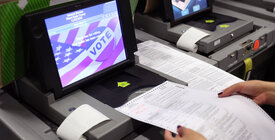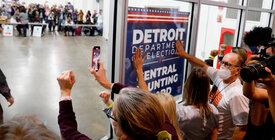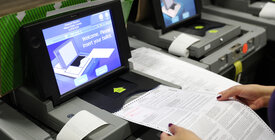
Estimated Costs for Protecting Election Infrastructure Against Insider Threats
We estimate that the nationwide five-year cost for basic security measures is approximately $316 million dollars.

Part of
To view our breakdown of cost estimates, click here.
Last December, the Brennan Center published an analysis of insider threats to our election system. Put simply, these are threats to the integrity of the election system from the very workers we entrust with running it.
Election workers are frequently the unsung heroes of American democracy. This was especially in 2020, when election workers from both parties stood up to political pressure and threats to their safety to ensure that all eligible Americans could vote and have their votes counted. But today, there is widespread agreement among many of those election workers that we should do more to defend against the risk of insider threats and provide more assurance to the public that our elections will remain free and fair.
In the last few weeks, we’ve spoken to election officials who identified several steps for deterring insider threats and increasing confidence in election processes and results. The recommendations include restricting access to election systems to those who need access to perform official responsibilities, and only to the extent those responsibilities require it; installing tracking devices on physical objects such as records, voting machines, and ballots to keep track of those items at all times; and establishing transparent procedures and monitoring for inappropriate activity through camera surveillance.
As detailed below, we estimate the nationwide five-year cost for these basic security measures to be a net total of approximately $316 million. (Our national estimate is based on typical costs and election office needs; the actual cost — for larger jurisdictions in particular — may vary considerably based on the size of the office and staff as well as the security systems already in place). This, in addition to the estimated costs of other election security items that the Brennan Center previously calculated, would amount to well over $2 billion.
Restricting Access
Total cost for five years: $75 million
It is best practice to ensure that only individuals who need to have access to critical election systems, such as voting machines or election management systems, are permitted that access. A key card access control system can help ensure that only people who should have access to a secure area can access that area and that there is a log of every instance in which someone enters a secure area. Key card readers are recommended for areas that store voting equipment and other critical election infrastructure.
Based on average industry prices for such access control systems, we estimate it would cost $75.2 million over five years to install and maintain such systems nationwide.
Physical Asset Tracking Systems
Total cost for five years: $197 million
Physical asset tracking systems provide information to election officials on the location and movement of important equipment and materials, providing assurance that these resources are not tampered with or moved along an unexpected course. Election officials can use such systems to track the movement of ballots, equipment, and materials to and from polling places, monitor ballot drop boxes to see pick-ups and detect tampering, and check that all voting equipment remains in a secure location whenever not in use.
$196.7 million would provide enough money for one asset tag for each precinct and voting machine in the country plus five years of service and access to the tracking platform for each tag. This is a conservative estimate of the need for this product nationally, given the amount of critical equipment and materials that officials must monitor every election. For example, this estimate does not include asset tags for ballot drop boxes and electronic pollbooks. There have been incidents of individuals stealing the latter equipment.
Camera Surveillance
Total cost for five years: $27 million
Video surveillance helped officials in Colorado determine that unauthorized persons were given access to voting systems in one Colorado county. All election offices should be equipped with cameras and require 24-hour surveillance of voting machines, computers, and ballots, which can be reviewed and compared to access logs in the event of unauthorized activity. Where possible, that footage should be stored for at least two years. Funding of $27 million would provide each election jurisdiction in the United States with 2 to 10 cameras (depending on size and need of the jurisdiction) plus cloud storage for video.
Voter Registration and Election Management System Access Controls
Total cost estimate for five years: $17 million
Election offices should create unique, secure accounts for each individual authorized to access election systems and ensure that each entry into such systems can be tied to the specific authorized staff. Basic security measures should bolster these accounts, including endpoint encryption and multi-factor authentication. These services would cost an estimated $16.7 million nationwide, though costs may vary significantly based on state technology, and many jurisdictions would require additional ongoing IT support to maintain these services.
More from the Election Infrastructure Costs collection
-
Costs for Replacing Voting Equipment in 2024
While states continue to make progress in updating their voting equipment, additional funding for election security is needed. -
Estimated Costs for Protecting Election Workers from Threats of Physical Violence
The Brennan Center estimates that approximately $300 million is needed for key measures to keep election offices and workers physically secure for the next five years. -
Estimated Costs for Protecting Election Infrastructure Against Insider Threats
We estimate that the nationwide five-year cost for basic security measures is approximately $316 million dollars.





